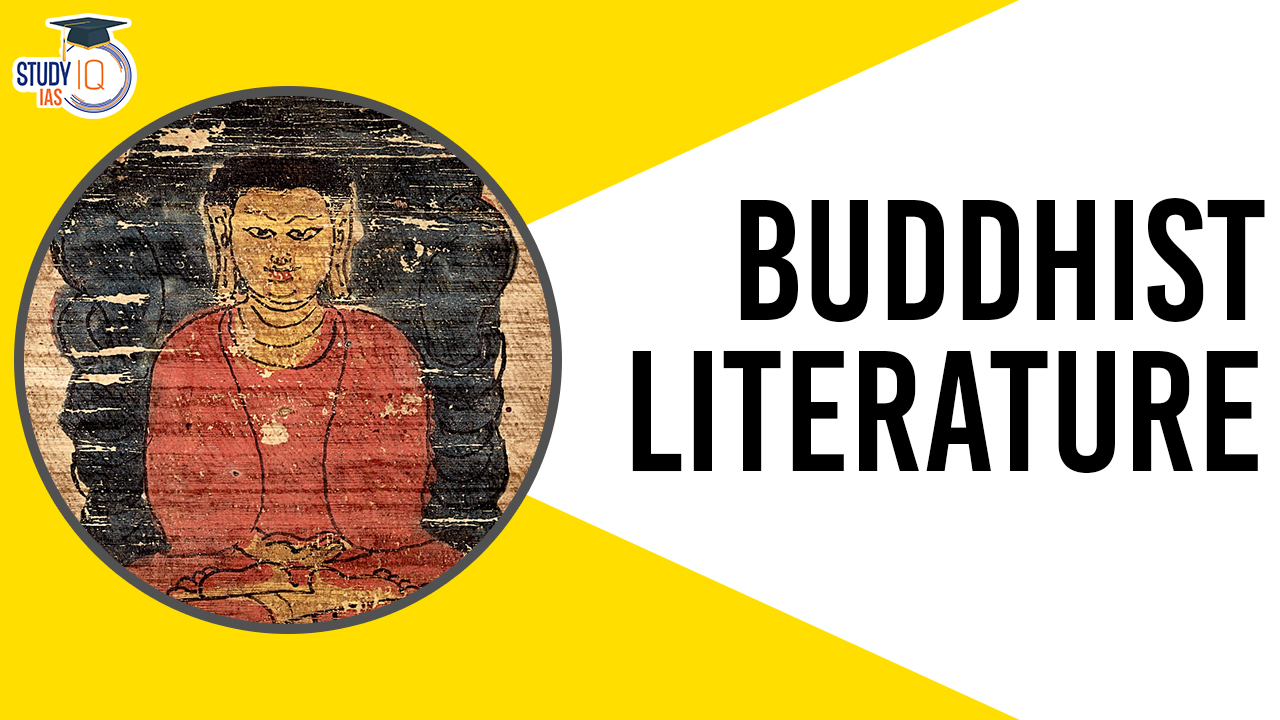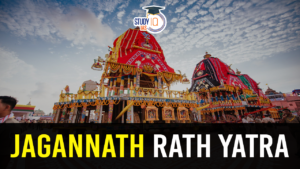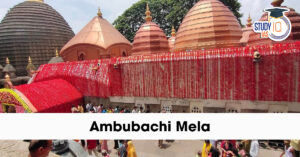Table of Contents
Buddhist literature is a vast body of religious and philosophical texts that form the foundation of Buddhism, one of the major world religions. These texts are essential for understanding the beliefs, practices, and teachings of Buddhism. The literature is written in various languages, including Pali, Sanskrit, Tibetan, Chinese, and others, reflecting the diverse cultural and historical contexts in which Buddhism has developed.
We’re now on WhatsApp. Click to Join
Buddhist Literature
Buddhist literature stands as one of India’s earliest organized collections, notably in the Pali Tripitakas—Sutta Pitaka, Vinaya Pitaka, and Abhidhamma Pitaka. Reflecting early followers’ emphasis on monastic life and scholasticism, these texts were chiefly composed by learned monks. Covering diverse themes like Buddha’s teachings, his life, followers, and the Sangha, they catered to both monks and the lay community. Originally in Pali, spoken in Magadha and South Bihar, these writings provide profound insights into Buddhism’s foundational principles, establishing a literary legacy that remains integral to the understanding of Buddhist philosophy and practice in Indian history.
Types of Buddhist Literature
Buddhist literature encompasses canonical and non-canonical works. Canonical texts, represented by the Tripitakas (Vinaya, Sutta, Abhidhamma Pitakas), form the core teachings. Non-canonical literature includes diverse works like Dipavamsa and Mahavamsa detailing Sri Lanka’s history, Milinda Panha capturing dialogues between Nagasena and King Menander, and Jatakas narrating moral stories of Buddha’s past lives. These texts, ranging from philosophical discourses to historical chronicles, offer a comprehensive understanding of Buddhist doctrine, history, and morality.
Canonical literature
The foundational texts of Buddhism, known as the Tripitakas or Three Baskets, represent the canonical literature.
Sutta Pitaka
The Sutta Pitaka is a significant component of the Pali Canon, comprising around 10,000 sutras related to the teachings of Buddha and his close associates. It not only presents the core doctrines of Buddhism but also addresses historical events, including the First Buddhist Council convened shortly after Buddha’s death. The Sutta Pitaka is divided into five Nikayas, each with a distinct focus:
- Digha Nikaya: Comprising long discourses, it explores profound themes and major doctrinal discussions.
- Majjhima Nikaya: Consisting of middle-length discourses, it provides a balanced approach to various aspects of Buddhist philosophy.
- Samyutta Nikaya: Organized by theme, this section contains connected discourses that delve into specific topics in a systematic manner.
- Anguttara Nikaya: Arranged numerically, it explores teachings based on numerical patterns, offering systematic and progressive insights.
- Khuddaka Nikaya: A collection of miscellaneous texts, including the Theragatha (verses of senior monks) and Therigatha (verses of senior nuns), providing diverse perspectives on the Buddhist path.
Vinaya Pitaka
Known as the “Book of Discipline,” the Vinaya Pitaka outlines the monastic rules and regulations for monks and nuns. It plays a crucial role in governing the conduct of the monastic community. The Vinaya Pitaka is divided into three books:
- Suttavibhanga: A compilation of rules for monastic discipline, outlining appropriate behavior and ethical standards.
- Khandhaka: This book deals with various aspects of monastic life, including rules for communal living, ordination procedures, and the conduct of monastic assemblies.
- Parivara: A summary and overview of the rules found in the Suttavibhanga and Khandhaka, serving as a comprehensive guide to the Vinaya.
Abhidhammapitaka
The Abhidhammapitaka, often referred to as the “Philosophical Basket,” delves into the philosophical and doctrinal aspects of Buddhism. It is divided into seven books:
- Dhammasangani: A systematic enumeration and classification of mental and physical phenomena.
- Dhatukatha: Explores fundamental elements and their relationships.
- Vibhanga: Analyzes various topics, including the factors leading to enlightenment.
- Puggalapannatti: Describes different types of individuals and their characteristics.
- Kathavatthu: Addresses points of controversy and debate within the Buddhist community.
- Yamaka: An analytical work presenting pairs of questions and answers for clarity.
- Patthana: Elaborates on the principles of causality, outlining the 24 conditional relations that govern phenomena.
Non-Canonical Literature
A vast body of non-canonical literature emerged primarily as commentaries to elucidate canonical texts for monks outside India.
Jatakas: The Jatakas are a collection of stories that recount the previous births (past lives) of Siddhartha Gautama, who would later become the Buddha. These stories are presented in the form of poems and illustrate moral lessons and virtues. The Jatakas serve not only as narratives about the Buddha’s past lives but also as instructive tales conveying ethical principles. The collection is extensive, containing numerous Jataka stories that highlight the importance of compassion, self-sacrifice, and other virtues on the path to enlightenment.
Milinda Panha: Milinda Panha, also known as the Questions of King Milinda, is a Pali text that records the philosophical dialogue between the Buddhist monk Nagasena and King Menander I, an Indo-Greek ruler. The conversations cover a wide range of topics, including Buddhist doctrines, ethics, and metaphysics. This text is highly valued for its insightful discussions on the nature of self, the concept of emptiness, and the path to enlightenment. It provides a unique blend of Buddhist thought and Hellenistic philosophical inquiry.
Dipavamsa: Dipavamsa, meaning “Chronicle of the Island,” is the oldest historical record of Sri Lanka. Composed in Pali, it traces the history of Buddhism in Sri Lanka from the time of Buddha’s visit to the island up to the reign of King Mahasena. Dipavamsa is considered a crucial source for understanding the early history of Buddhism in Sri Lanka, providing insights into the establishment of the Sangha and the introduction of Buddhism to the island.
Mahavamsa: Mahavamsa, or “Great Chronicle,” is a significant Pali epic poem that narrates the history of Sri Lanka. Similar to the Dipavamsa, it covers the period from the legendary arrival of Prince Vijaya to the reign of King Mahasena. The Mahavamsa is particularly notable for its historical tone, detailing the lineage of Sri Lankan kings and their contributions to Buddhism. It is one of the longest and most comprehensive historical accounts among Buddhist literature, offering a valuable source for understanding the cultural and religious history of Sri Lanka.
Buddha Charita: Buddha Charita, authored by the Indian poet Ashvaghosha in Sanskrit, is a significant literary work that primarily focuses on the life of Buddha. It is one of the earliest biographical accounts of the Buddha’s life and serves as both an epic poem and a philosophical discourse. The text explores Siddhartha Gautama’s journey from his princely life to enlightenment, emphasizing key events, teachings, and the impact of his spiritual transformation on the world. Buddha Charita is highly regarded for its poetic beauty and its contribution to the portrayal of Buddha’s life in classical Sanskrit literature.
Sanskrit texts in Buddhist literature
Sanskrit texts play a significant role in Buddhist literature, contributing to the rich tapestry of philosophical, doctrinal, and narrative traditions within Buddhism. Here are some notable Sanskrit texts in Buddhist literature:
- Buddha Charita by Asvaghosa (80-150 AD):
- An epic poem in the Sanskrit Mahakavya style, narrating the life and teachings of Gautama Buddha.
- Saundarananda by Asvaghosa:
- A Sanskrit kavya poem focused on the conversion of Nanda, Buddha’s half-brother, depicting his life and expounding Buddhist doctrines and ascetic practices.
- Sutralankar by Asvaghosa:
- Explores various aspects of Buddhist scriptures, contributing to the broader understanding of Buddhist philosophy.
- Sariputra Prakaran by Asvaghosa:
- Devoted to Sariputta, a prominent disciple of Buddha, discussing his leadership role in the ministry and his appearances in Mahayana sutras.
- Vajra Suchi by Asvaghosa:
- A specimen of Buddhist polemical writing addressing the caste system advocated by Vedic schools.
- Mahavibhasa Shastra by Vasumitra:
- An encyclopedic work on Abhidhamma, contributing to the foundation of the Vaibhasika school of thought.
- Visuddhimagga (Path of Purification) by Buddhaghosha (5th century):
- A comprehensive summary of older Sinhala commentaries on Theravada teachings and practices, written in Sanskrit.
- Sumangalvasini by Buddhaghosha:
- A commentary on the Vinaya Pitaka, providing insights into the rules and regulations governing the monastic community.
- Atthakathayen by Buddhaghosha:
- An exposition on the Jataka stories, offering interpretations and explanations of these moral tales.
- Madhyamika Karika by Nagarjuna (150-250 CE):
- A foundational text of the Madhyamaka school, presenting key philosophical concepts within Mahayana Buddhism.
- Prajnaparamita Karika by Nagarjuna:
- Expounds transcendental knowledge in both Mahayana and Theravada Buddhism, emphasizing the wisdom personified as Prajnaparamita Devi.
- Lalitavistara Sutra (Anonymous):
- Tells the story of Gautama Buddha from his descent from Tushita until his first sermon, preserving crucial elements of the Buddha’s life.
- Mahyanasamgraha (Anonymous):
- A summary of the teachings of the Great Vehicle, contributing to the understanding of Mahayana Buddhism.
- Abhidharma-samuccaya (Anonymous):
- A summary of key Mahayana Abhidharma doctrines, delving into advanced philosophical and metaphysical aspects.
Buddhist Literature UPSC
Buddhist literature, a foundational element of Buddhism, comprises a vast collection of religious and philosophical texts essential for comprehending the beliefs, practices, and teachings of this major world religion. Composed in languages such as Pali, Sanskrit, Tibetan, Chinese, and more, these texts reflect Buddhism’s diverse cultural evolution. The Pali Tripitakas, encompassing Sutta Pitaka, Vinaya Pitaka, and Abhidhamma Pitaka, form the core. Canonical literature, emphasized by early followers, was primarily crafted by learned monks, addressing themes from Buddha’s teachings to monastic discipline. Non-canonical works, like Dipavamsa and Jatakas, offer historical insights and moral stories. Sanskrit texts, including Buddha Charita and Madhyamika Karika, contribute significantly, enriching Buddhist literature’s philosophical and doctrinal dimensions.


 Bonalu Festival 2025: Date, History, Rit...
Bonalu Festival 2025: Date, History, Rit...
 Puri Jagannath Rath Yatra 2025, History,...
Puri Jagannath Rath Yatra 2025, History,...
 Ambubachi Mela 2025: Dates, Rituals, Sig...
Ambubachi Mela 2025: Dates, Rituals, Sig...





















